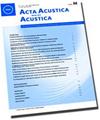一维有限元法与传递矩阵法在管乐器阻抗计算中的比较
Q1 Arts and Humanities
引用次数: 8
摘要
本文提出了一种计算工具,用于计算具有粘热损耗的线性平面波传播背景下的管乐器输入阻抗。该方法的独创性在于使用了一种具体而简单的一维有限元方法。还回顾了流行的传递矩阵法(TMM),并提出了一种统一圆柱与锥体情况的无缝公式。当考虑任意形状时,该方法没有准确地考虑系统中的自然耗散粘热损失。等效半径的引入导致了我们用有限元方法量化的近似。给出了用TMM实际解出的方程。对两种方法(有限元法和TMM法)的精度和计算次数进行了评价和比较。虽然TMM在无损情况和有损圆柱体情况下效率更高,但FEM在有损小号的实际情况下以特定精度为目标时效率更高。一些附加的特征也显示了FEM相对于TMM的鲁棒性和灵活性。本文的所有结果都是使用开源python工具箱OpenWind计算的。本文章由计算机程序翻译,如有差异,请以英文原文为准。
A Comparison of a One-Dimensional Finite Element Method and the Transfer Matrix Method for the Computation of Wind Music Instrument Impedance
This work presents a computation tool for the calculation of wind instrument input impedance in the context of linear planar wave propagation with visco-thermal losses. The originality of the approach lies in the usage of a specific and simple 1D finite element method (FEM). The popular
Transfer Matrix Method (TMM) is also recalled and a seamless formulation is proposed which unifies the cases cylinders vs. cones. Visco-thermal losses, which are natural dissipation in the system, are not exactly taken into account by this method when arbitrary shapes are considered. The introduction
of an equivalent radius leads to an approximation that we quantify using the FEM method. The equation actually solved by the TMM in this case is exhibited. The accuracy of the two methods (FEM and TMM) and the associated computation times are assessed and compared. Although the TMM is more
efficient in lossless cases and for lossy cylinders, the FEM is shown to be more efficient when targeting a specific precision in the realistic case of a lossy trumpet. Some additional features also exhibit the robustness and flexibility of the FEM over the TMM. All the results of this article
are computed using the open-source python toolbox OpenWind.
求助全文
通过发布文献求助,成功后即可免费获取论文全文。
去求助
来源期刊
CiteScore
2.60
自引率
0.00%
发文量
0
审稿时长
6.8 months
期刊介绍:
Cessation. Acta Acustica united with Acustica (Acta Acust united Ac), was published together with the European Acoustics Association (EAA). It was an international, peer-reviewed journal on acoustics. It published original articles on all subjects in the field of acoustics, such as
• General Linear Acoustics, • Nonlinear Acoustics, Macrosonics, • Aeroacoustics, • Atmospheric Sound, • Underwater Sound, • Ultrasonics, • Physical Acoustics, • Structural Acoustics, • Noise Control, • Active Control, • Environmental Noise, • Building Acoustics, • Room Acoustics, • Acoustic Materials and Metamaterials, • Audio Signal Processing and Transducers, • Computational and Numerical Acoustics, • Hearing, Audiology and Psychoacoustics, • Speech,
• Musical Acoustics, • Virtual Acoustics, • Auditory Quality of Systems, • Animal Bioacoustics, • History of Acoustics.

 求助内容:
求助内容: 应助结果提醒方式:
应助结果提醒方式:


